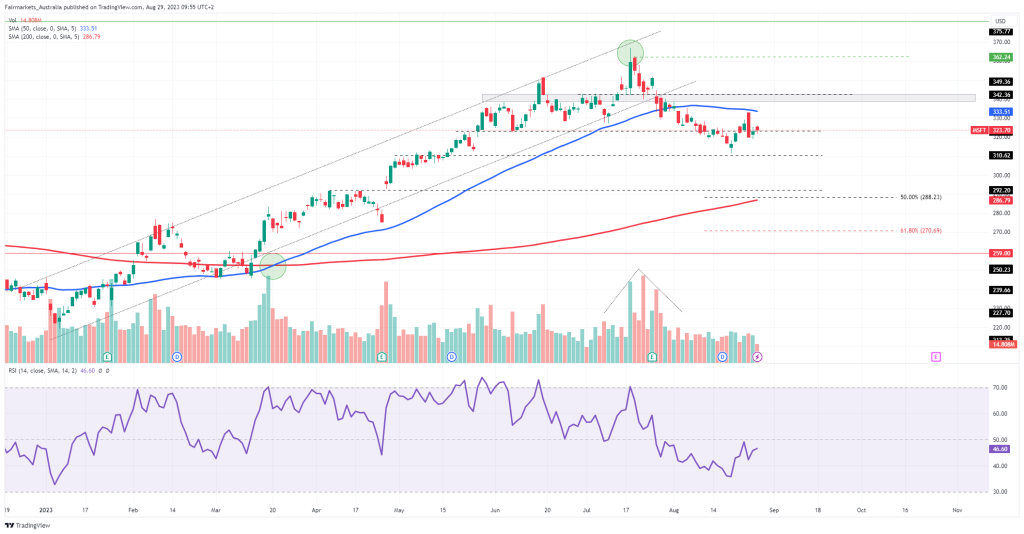Embracing a legacy of technological revolution, Microsoft Corporation (NASDAQ: MSFT) has unlocked a mesmerizing tale of innovation since its inception. With a captivating array of intricate product offerings, this industry juggernaut has consistently commanded the vanguard of technological evolution. The past decade alone has borne witness to a staggering surge of nearly 900% in returns, leaving investors enthralled by the astronomical trajectory of its performance. As the dust of transformation settles, an intriguing question emerges: Will this technological titan sustain its remarkable odyssey, continuing to forge pathways towards enriching its investors?
Their fourth-quarter earnings report for fiscal 2024 certainly suggested so in its 25 July release. Revenue climbed another 8% to a staggering $56.2Bn, aiding a 21% rise in earnings per share (EPS) to $2.69. For the full year, revenue was up 7% to $211.9Bn, with EPS following closely with a 7% increase to $9.81. The stand-out performer was its fast-growing cloud services, as its Azure and other cloud services revenue expanded 26%. This outperformance was slightly offset by a 4% decline in the more personal computing segment. Still, this segment only contributed $13.9Bn in revenue, therefore not moving the needle as much from a holistic perspective.
Technical
On the 1D chart, a high-volume pullback from the recent ascending channel has sustained from its peak at $362.24 toward support at $310.62. With the buyers and sellers fighting it out around crucial resistance from the 50-SMA at $333.51, the medium-term momentum is vulnerable to a fundamental shift.
If the 50-SMA resistance holds, the share price could trickle down for a retest at $310.62, with a daily close below this support signalling a potential bearish trend reversal from the prior channel. In this case, lower support at $292.20 stands in the way of the selling pressure reaching the Fibonacci midpoint at $288.23, close to the 200-SMA support. The Fibonacci golden ratio at $270.69 could offer further support if the price moves below the 200-SMA.
However, a break above the 50-SMA in upcoming sessions could signal a bullish continuation, where resistance is established at $342.36. The psychological resistance at the previous peak of $362.24 then stands in the way of the share price converging with its estimated fair value of $380.93, which offers a 17.5% potential upside from current levels.

Fundamental
It has been a challenging macroeconomic landscape to navigate for most businesses in 2023 thus far. With inflationary pressures reigning over the market, the Federal Reserve has raised the Federal Funds Rate eleven times from 0.25% – 0.50% in March 2022 to 5.25% – 5.50% in July 2023. The graph below shows the year-to-date performance of different factor groups. Surprisingly, value stocks have suffered the most, and one would usually expect these stocks to insulate against market pressures. However, with the purchasing power of the income returns diminishing with the surging inflation, they have struggled immensely. Small-cap growth stocks have also struggled as the cost of debt to finance growth opportunities has surged. Surprisingly, large-cap growth and growth stocks, in general, have faired the best in the first eight months of the year. Microsoft falls in this scope, with its 34.98% year-to-date price return. While interest rates generally weigh on this factor group, the boom in artificial intelligence has sparked optimism around the growth prospects of these firms, particularly those winning the race toward monetizing AI. Microsoft has placed itself well to benefit from this trend with its strategic investment into OpenAI and the popular ChatGPT. However, can they sustain this performance if the hype around AI fades, given the challenging economy?

Source: FairMarkets Australia – Koyfin, Tiaan van Aswegen
This upcoming week will undoubtedly be a good indicator, as the US reports personal consumption expenditure (PCE) data and Non-Farm Payrolls (NFP). After Jerome Powell signalled at the Jackson Hole Symposium that the door remains open for additional rate hikes this year, investors could keep a close eye on the economic developments for signals of the interest rate path. The effect of these expectations on the company’s performance can be seen below. Recently, the US treasury yields surged, aiding the pullback in the technology sector. These high-growth stocks typically tend to move inversely with the US yields due to their sensitivity to interest rates. The chart below shows the optimistic company performance, with the Nasdaq 100 index following closely during times of declining yields, while rising yields tend to trigger the opposite effect. Developments in the data releases this week could certainly move the US treasury yields as the market reprices its interest rate expectations, which could cause movements in Microsoft’s share price.

Source: FairMarkets Australia – Koyfin, Tiaan van Aswegen
As a growth stock, Microsoft also showcases some characteristics of a quality stock through its impressive profit-generating ability. Within the universe of information technology companies globally, Microsoft ranks above the 90th percentile in the majority of its profitability metrics. Its lowest ranking is its gross profit margin, which currently sits at 69.84%, which is not low by any stretch of the imagination.

Source: FairMarkets Australia – Koyfin, Tiaan van Aswegen
However, their impressive profitability comes at a price. The chart below shows the company’s valuation ranking within the scope of global companies worldwide, with a higher percentile referring to a higher valuation. Once again, Microsoft sits high on the spectrum, with its EV/EBIT having the lowest ranking in the 72nd percentile, currently sitting at 26.8X. Its high P/B and P/S ratios signal that the market has priced in significant growth from where the company is currently situated. So, where will these growth opportunities come from?

Source: FairMarkets Australia – Koyfin, Tiaan van Aswegen
Microsoft has positioned itself well within several growth markets. The Software as a Service (SaaS) market is expected to grow at a rate of 13.7% annually over the next seven years to 2030. Last year, Microsoft accounted for 16.4% of sales in this segment, holding twice as much market share as its closest competitor. Secondly, its cloud computing segment promises healthy growth over the next few years. Analysts estimate this market segment to expand at 14.1% annually through 2030. Microsoft Azure is the world’s second-largest Cloud Infrastructure & Platform Services provider (CIPS) and is quickly gaining share with its AI supercomputing infrastructure. As we advance, Microsoft aims to boost these two market segments with generative AI. Through their offering of Microsoft 365 Copilot, users can use AI to write and edit content in Microsoft Word while creating presentations on PowerPoint and analyzing data in Excel.
On the other hand, Dynamics 365 Copilot aims to leverage AI to improve sales and marketing outcomes and create a more efficient supply chain for internal efficiency. Through its partnership with OpenAI, Azure users will also gain exclusive access to the GPT large language models (LLMs), which developers can use to create their own generative AI software. This prospect could be a massive demand driver for Azure, as it could entice enterprises to use Azure to gain access to these popular LLMs.
As previously mentioned, Microsoft’s more personal computing segment has been its weak point in recent quarters. Xbox content and services revenue growth slowed to 5%, with devices revenue down 20%. However, there has been optimism about acquiring Activision Blizzard, which could drive improvements in this sector. While the company hit hurdles from UK regulators in approving the acquisition, there has been a restructuring in the deal that could help get it over the line. To address the concerns of the UK Competition & Markets Authority (CMA), the restructuring will involve the transfer of the cloud streaming rights of all current and new Activision PC and Console games due for release over the next 15 years to Ubisoft Entertainment. As a result, Microsoft will not have exclusive rights to release these Activision games on Xbox Cloud, its cloud streaming service, nor will it have exclusive control over the licensing terms. However, Ubisoft will pay Microsoft for these rights through a once-off payment, followed by a wholesale pricing mechanism.
Summary
In the short term, Microsoft could be vulnerable to economic developments from US inflation and labour data. However, with its dominant positioning in the SaaS and Cloud Computing markets, its efforts to monetize AI have put the company at the forefront of AI growth as we advance. From current levels, the estimated fair value of $380.93 offers a 17.5% potential upside.
Sources: Koyfin, Tradingview, Reuters, Forbes Advisor, Microsoft Corporation


